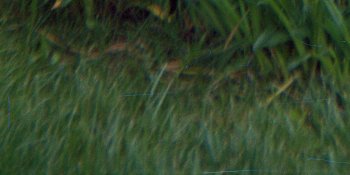Denverdad
Member
The attachments below illustrate a problem I experienced recently with a 120 roll of Kodak Portra 400NC. The roll came back from the lab looking fine overall; but on closer inspection I noticed that most of the frames had a spattering of small filament-like defects. The first attachment shows the overall image for reference, while the second shows a crop from near the lower left corner which had a particularly dense distribution of these artifacts.
Under a loop the defects show up on the negatives themselves with a strong mask-color (i.e., orange). In positive form they are an almost neon-blue color. For lack of a better description, it looks almost as if someone sprayed a can of silly string over my negatives! They appear in random locations and on some frames only extremely sparsely. They also aren't typical of scratches I have seen since they are not straight, long, or all in the same direction.
So does anyone recognize this as a particular processing error which may have occurred at the lab? For my part I can say that I probably handled the roll more than is typical - it was part of a series of rolls I exposed with a 620 camera (a Meteor, not that it should really matter), so I had to first re-spool the film onto a 620 spool before loading it into the camera. That handling seems unlikely as the cause since I have run many re-spooled B&W rolls through this camera and subsequently processed them myself without ever seeing any evidence of these odd artifacts. Since this was my first use of color negative film in quite a while, I am trying to get a handle on whether these artifacts are due to my lab, or rather something I am causing myself.
Any ideas?
Jeff
Under a loop the defects show up on the negatives themselves with a strong mask-color (i.e., orange). In positive form they are an almost neon-blue color. For lack of a better description, it looks almost as if someone sprayed a can of silly string over my negatives! They appear in random locations and on some frames only extremely sparsely. They also aren't typical of scratches I have seen since they are not straight, long, or all in the same direction.
So does anyone recognize this as a particular processing error which may have occurred at the lab? For my part I can say that I probably handled the roll more than is typical - it was part of a series of rolls I exposed with a 620 camera (a Meteor, not that it should really matter), so I had to first re-spool the film onto a 620 spool before loading it into the camera. That handling seems unlikely as the cause since I have run many re-spooled B&W rolls through this camera and subsequently processed them myself without ever seeing any evidence of these odd artifacts. Since this was my first use of color negative film in quite a while, I am trying to get a handle on whether these artifacts are due to my lab, or rather something I am causing myself.
Any ideas?
Jeff












